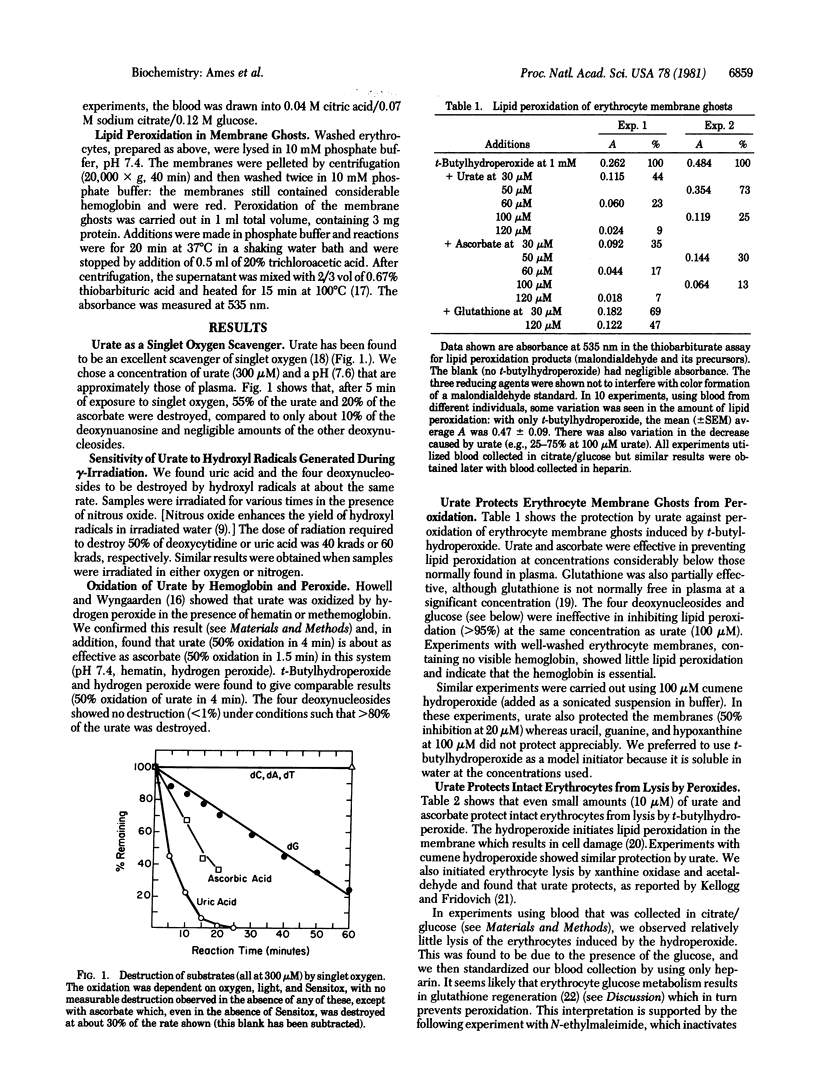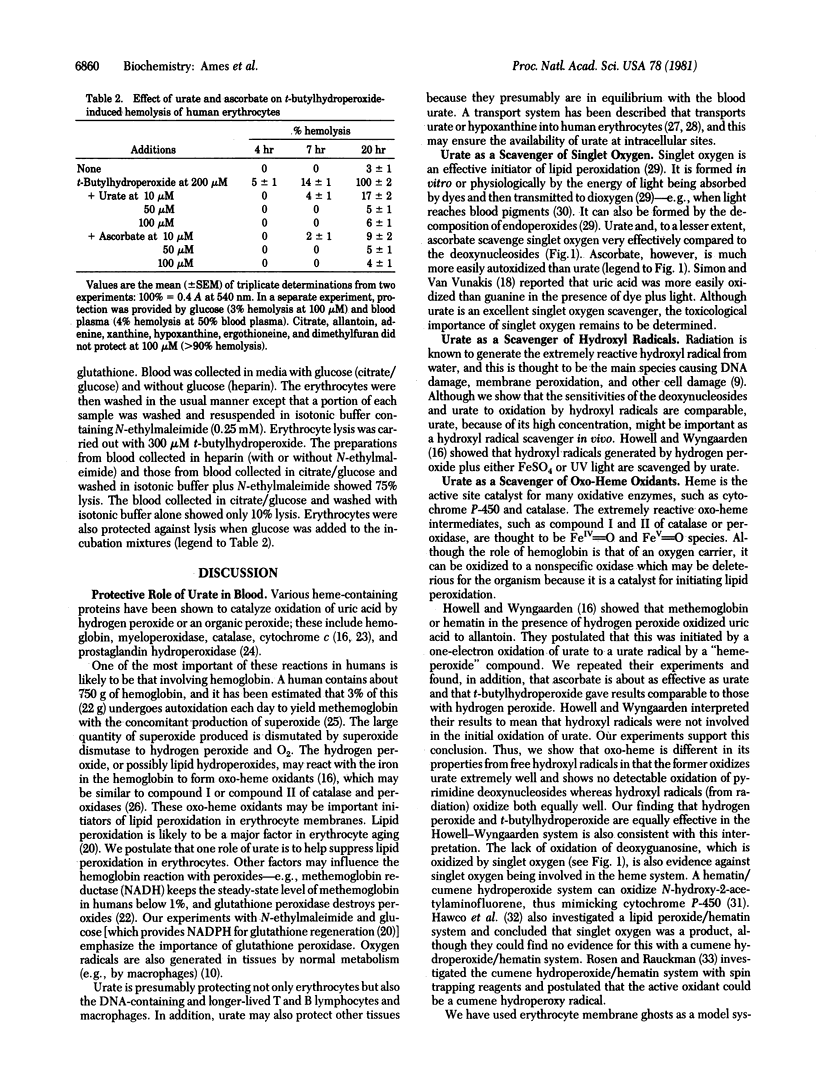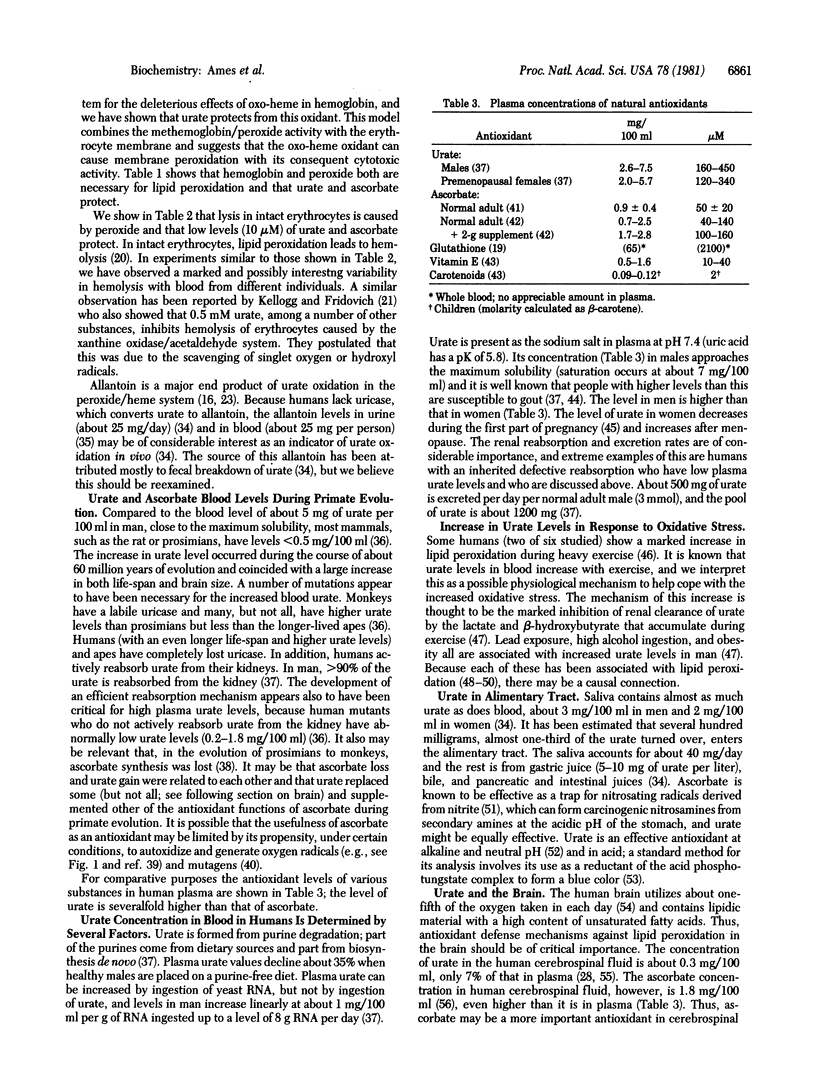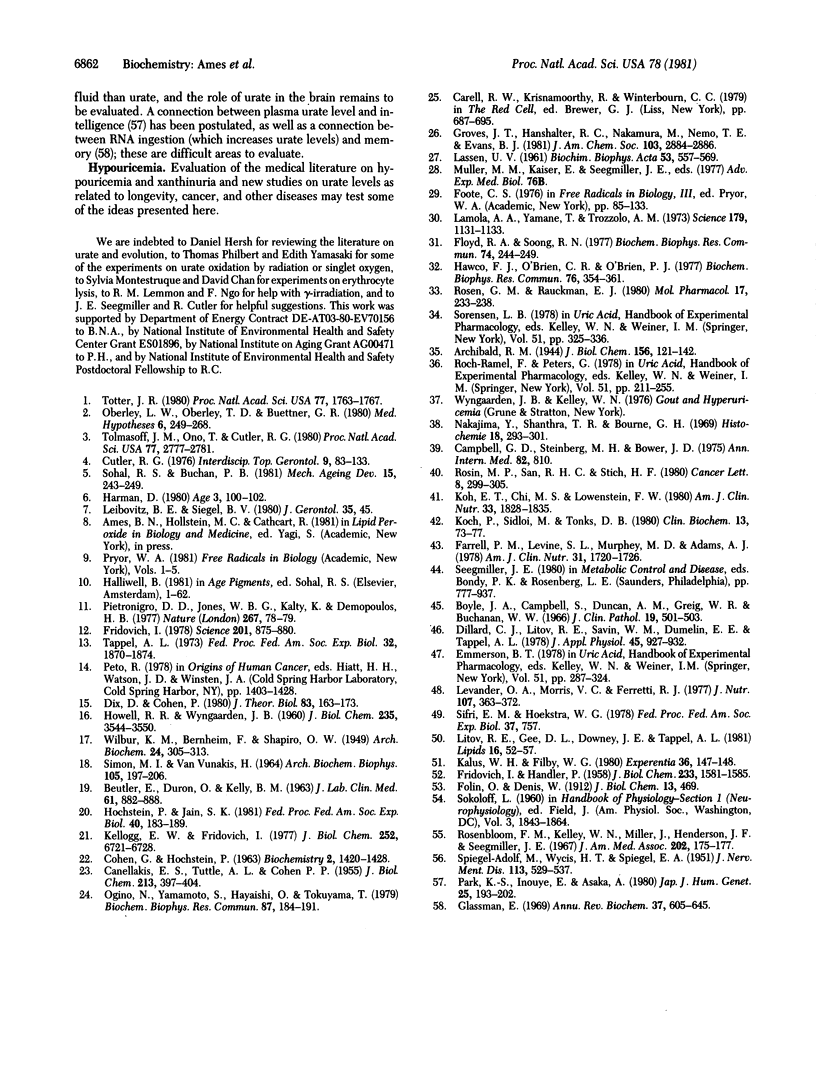Abstract
During primate evolution, a major factor in lengthening life-span and decreasing age-specific cancer rates may have been improved protective mechanisms against oxygen radicals. We propose that one of these protective systems is plasma uric acid, the level of which increased markedly during primate evolution as a consequence of a series of mutations. Uric acid is a powerful antioxidant and is a scavenger of singlet oxygen and radicals. We show that, at physiological concentrations, urate reduces the oxo-heme oxidant formed by peroxide reaction with hemoglobin, protects erythrocyte ghosts against lipid peroxidation, and protects erythrocytes from peroxidative damage leading to lysis. Urate is about as effective an antioxidant as ascorbate in these experiments. Urate is much more easily oxidized than deoxynucleosides by singlet oxygen and is destroyed by hydroxyl radicals at a comparable rate. The plasma urate levels in humans (about 300 microM) is considerably higher than the ascorbate level, making it one of the major antioxidants in humans. Previous work on urate reported in the literature supports our experiments and interpretations, although the findings were not discussed in a physiological context.
Full text
PDF




Selected References
These references are in PubMed. This may not be the complete list of references from this article.
- BEUTLER E., DURON O., KELLY B. M. Improved method for the determination of blood glutathione. J Lab Clin Med. 1963 May;61:882–888. [PubMed] [Google Scholar]
- Boyle J. A., Campbell S., Duncan A. M., Greig W. R., Buchanan W. W. Serum uric acid levels in normal pregnancy with observations on the renal excretion of urate in pregnancy. J Clin Pathol. 1966 Sep;19(5):501–503. doi: 10.1136/jcp.19.5.501. [DOI] [PMC free article] [PubMed] [Google Scholar]
- CANELLAKIS E. S., TUTTLE A. L., COHEN P. P. A comparative study of the end-products of uric acid oxidation by peroxidases. J Biol Chem. 1955 Mar;213(1):397–404. [PubMed] [Google Scholar]
- COHEN G., HOCHSTEIN P. GLUTATHIONE PEROXIDASE: THE PRIMARY AGENT FOR THE ELIMINATION OF HYDROGEN PEROXIDE IN ERYTHROCYTES. Biochemistry. 1963 Nov-Dec;2:1420–1428. doi: 10.1021/bi00906a038. [DOI] [PubMed] [Google Scholar]
- Campbell G. D., Jr, Steinberg M. H., Bower J. D. Letter: Ascorbic acid-induced hemolysis in G-6-PD deficiency. Ann Intern Med. 1975 Jun;82(6):810–810. doi: 10.7326/0003-4819-82-6-810_1. [DOI] [PubMed] [Google Scholar]
- Dillard C. J., Litov R. E., Savin W. M., Dumelin E. E., Tappel A. L. Effects of exercise, vitamin E, and ozone on pulmonary function and lipid peroxidation. J Appl Physiol Respir Environ Exerc Physiol. 1978 Dec;45(6):927–932. doi: 10.1152/jappl.1978.45.6.927. [DOI] [PubMed] [Google Scholar]
- Dix D., Cohen P., Flannery J. On the role of aging in cancer incidence. J Theor Biol. 1980 Mar 7;83(1):163–173. doi: 10.1016/0022-5193(80)90377-x. [DOI] [PubMed] [Google Scholar]
- FRIDOVICH I., HANDLER P. Xanthine oxidase. IV. Participation of iron in internal electron transport. J Biol Chem. 1958 Dec;233(6):1581–1585. [PubMed] [Google Scholar]
- Farrell P. M., Levine S. L., Murphy M. D., Adams A. J. Plasma tocopherol levels and tocopherol-lipid relationships in a normal population of children as compared to healthy adults. Am J Clin Nutr. 1978 Oct;31(10):1720–1726. doi: 10.1093/ajcn/31.10.1720. [DOI] [PubMed] [Google Scholar]
- Floyd R. A., Soong L. M. Obligatory free radical intermediate in the oxidative activation of the carcinogen N-hydroxy-2-acetylaminofluorene. Biochim Biophys Acta. 1977 Jun 23;498(1):244–249. doi: 10.1016/0304-4165(77)90104-0. [DOI] [PubMed] [Google Scholar]
- Fridovich I. The biology of oxygen radicals. Science. 1978 Sep 8;201(4359):875–880. doi: 10.1126/science.210504. [DOI] [PubMed] [Google Scholar]
- Glassman E. The biochemistry of learning: an evaluation of the role of RNA and protein. Annu Rev Biochem. 1969;38:605–646. doi: 10.1146/annurev.bi.38.070169.003133. [DOI] [PubMed] [Google Scholar]
- HOWELL R. R., WYNGAARDEN J. B. On the mechanism of peroxidation of uric acids by hemoproteins. J Biol Chem. 1960 Dec;235:3544–3550. [PubMed] [Google Scholar]
- Hawco F. J., O'Brien P. J. Singlet oxygen formation during hemoprotein catalyzed lipid peroxide decomposition. Biochem Biophys Res Commun. 1976 May 23;76(2):354–361. doi: 10.1016/0006-291x(77)90732-x. [DOI] [PubMed] [Google Scholar]
- Hochstein P., Jain S. K. Association of lipid peroxidation and polymerization of membrane proteins with erythrocyte aging. Fed Proc. 1981 Feb;40(2):183–188. [PubMed] [Google Scholar]
- Kalus W. H., Filby W. G. Inhibition of nitrosamine formation by ascorbic acid: participation of free radicals in its anaerobic reaction with nitrite. Experientia. 1980 Feb 15;36(2):147–149. doi: 10.1007/BF01953698. [DOI] [PubMed] [Google Scholar]
- Kellogg E. W., 3rd, Fridovich I. Liposome oxidation and erythrocyte lysis by enzymically generated superoxide and hydrogen peroxide. J Biol Chem. 1977 Oct 10;252(19):6721–6728. [PubMed] [Google Scholar]
- Koch P., Sidloi M., Tonks D. B. Estimation of serum ascorbic acid in patients and the effect of ascorbic acid and its oxidation products on SMA 12/60 parameters. Clin Biochem. 1980 Apr;13(2):73–77. doi: 10.1016/s0009-9120(80)91223-0. [DOI] [PubMed] [Google Scholar]
- Koh E. T., Chi M. S., Lowenstein F. W. Comparison of selected blood components by race, sex, and age. Am J Clin Nutr. 1980 Aug;33(8):1828–1835. doi: 10.1093/ajcn/33.8.1828. [DOI] [PubMed] [Google Scholar]
- LASSEN U. V. Kinetics of uric acid transport in human erythrocytes. Biochim Biophys Acta. 1961 Nov 11;53:557–569. doi: 10.1016/0006-3002(61)90215-3. [DOI] [PubMed] [Google Scholar]
- Lamola A. A., Yamane T., Trozzolo A. M. Cholesterol hydroperoxide formation in red cell membranes and photohemolysis in erythropoietic protoporphyria. Science. 1973 Mar 16;179(4078):1131–1133. doi: 10.1126/science.179.4078.1131. [DOI] [PubMed] [Google Scholar]
- Leibovitz B. E., Siegel B. V. Aspects of free radical reactions in biological systems: aging. J Gerontol. 1980 Jan;35(1):45–56. doi: 10.1093/geronj/35.1.45. [DOI] [PubMed] [Google Scholar]
- Levander O. A., Morris V. C., Ferretti R. J. Filterability of erythrocytes from vitamin E-deficient lead-poisoned rats. J Nutr. 1977 Mar;107(3):363–372. doi: 10.1093/jn/107.3.363. [DOI] [PubMed] [Google Scholar]
- Litov R. E., Gee D. L., Downey J. E., Tappel A. L. The role of peroxidation during chronic and acute exposure to ethanol as determined by pentane expiration in the rat. Lipids. 1981 Jan;16(1):52–63. doi: 10.1007/BF02534921. [DOI] [PubMed] [Google Scholar]
- Nakajima Y., Shantha T. R., Bourne G. H. Histochemical detection of L-gulonolactone: phenazine methosulfate oxidoreductase activity in several mammals with special reference to synthesis of vimin C in primates. Histochemie. 1969;18(4):293–301. doi: 10.1007/BF00279880. [DOI] [PubMed] [Google Scholar]
- Oberley L. W., Oberley T. D., Buettner G. R. Cell differentiation, aging and cancer: the possible roles of superoxide and superoxide dismutases. Med Hypotheses. 1980 Mar;6(3):249–268. doi: 10.1016/0306-9877(80)90123-1. [DOI] [PubMed] [Google Scholar]
- Ogino N., Yamamoto S., Hayaishi O., Tokuyama T. Isolation of an activator for prostaglandin hydroperoxidase from bovine vesicular gland cytosol and its identification as uric acid. Biochem Biophys Res Commun. 1979 Mar 15;87(1):184–191. doi: 10.1016/0006-291x(79)91664-4. [DOI] [PubMed] [Google Scholar]
- Park K. S., Inouye E., Asaka A. Plasma and urine uric acid levels: heritability estimates and correlation with IQ. Jinrui Idengaku Zasshi. 1980 Sep;25(3):193–202. doi: 10.1007/BF01997695. [DOI] [PubMed] [Google Scholar]
- Pietronigro D. D., Barrie W., Jones G., Kalty K., Demopoulos H. B. Interaction of DNA and liposomes as a model for membrane-mediated DNA damage. Nature. 1977 May 5;267(5606):78–79. doi: 10.1038/267078a0. [DOI] [PubMed] [Google Scholar]
- Rosen G. M., Rauckman E. J. Spin trapping of the primary radical involved in the activation of the carcinogen N-hydroxy-2-acetylaminofluorene by cumene hydroperoxide-hematin. Mol Pharmacol. 1980 Mar;17(2):233–238. [PubMed] [Google Scholar]
- Rosenbloom F. M., Kelley W. N., Miller J., Henderson J. F., Seegmiller J. E. Inherited disorder of purine metabolism. Correlation between central nervous system dysfunction and biochemical defects. JAMA. 1967 Oct 16;202(3):175–177. doi: 10.1001/jama.202.3.175. [DOI] [PubMed] [Google Scholar]
- Rosin M. P., San R. H., Stich H. F. Mutagenic activity of ascorbate in mammalian cell cultures. Cancer Lett. 1980 Feb;8(4):299–305. doi: 10.1016/0304-3835(80)90145-7. [DOI] [PubMed] [Google Scholar]
- SIMON M. I., VANVUNAKIS H. THE DYE-SENSITIZED PHOTOOXIDATION OF PURINE AND PYRIMIDINE DERIVATIVES. Arch Biochem Biophys. 1964 Apr;105:197–206. doi: 10.1016/0003-9861(64)90253-x. [DOI] [PubMed] [Google Scholar]
- SPIEGEL-ADOLF M., WYCIS H. T., SPIEGEL E. A. Chemical analysis of spectrophotometric findings in the cerebrospinal fluid. J Nerv Ment Dis. 1951 Jun;113(6):529–537. [PubMed] [Google Scholar]
- Sohal R. S., Buchan P. B. Relationship between fluorescent age pigment, physiological age and physical activity in the housefly, Musca domestica. Mech Ageing Dev. 1981 Mar;15(3):243–249. doi: 10.1016/0047-6374(81)90133-0. [DOI] [PubMed] [Google Scholar]
- Tappel A. L. Lipid peroxidation damage to cell components. Fed Proc. 1973 Aug;32(8):1870–1874. [PubMed] [Google Scholar]
- Tolmasoff J. M., Ono T., Cutler R. G. Superoxide dismutase: correlation with life-span and specific metabolic rate in primate species. Proc Natl Acad Sci U S A. 1980 May;77(5):2777–2781. doi: 10.1073/pnas.77.5.2777. [DOI] [PMC free article] [PubMed] [Google Scholar]
- Totter J. R. Spontaneous cancer and its possible relationship to oxygen metabolism. Proc Natl Acad Sci U S A. 1980 Apr;77(4):1763–1767. doi: 10.1073/pnas.77.4.1763. [DOI] [PMC free article] [PubMed] [Google Scholar]
- WILBUR K. M., BERNHEIM F., SHAPIRO O. W. The thiobarbituric acid reagent as a test for the oxidation of unsaturated fatty acids by various agents. Arch Biochem. 1949 Dec;24(2):305–313. [PubMed] [Google Scholar]


